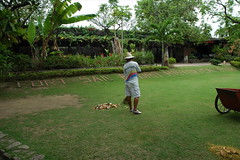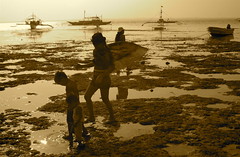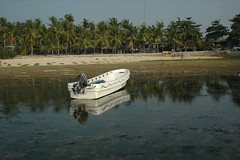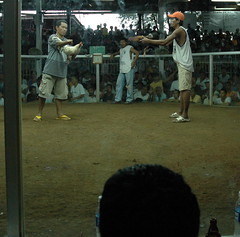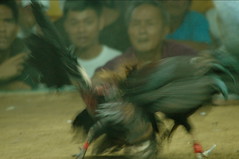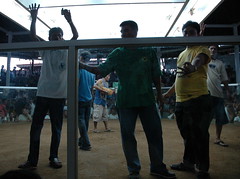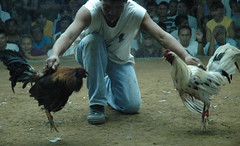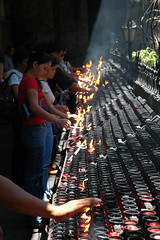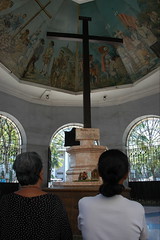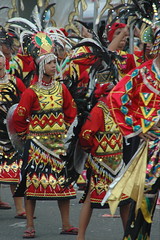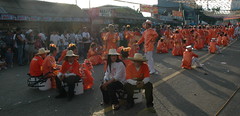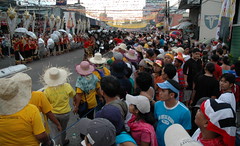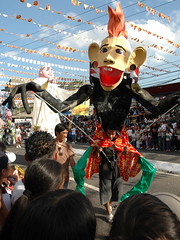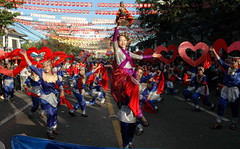Fort San Pedro, located at Cebu City’s wharf area, was the nucleus of the first Spanish settlement in the country. It began as a single triangular bastion, built in 1565, and was not completed for another 200 years. Over the centuries the fort has been put to several uses, including a watch-tower to counter pirate attacks in the 1700s, a prison for local rebels during the Philippine revolution, a US army barracks, and during world war II a prison camp. Today the fort has been turned into a museum-park, giving visitors to Cebu a glimpse of the island’s history.
Sunday, March 27, 2005
Walking in a tide pool
Early morning search in the tide pool... you find all kids of things hiding in the seaweed. Shells - Star Fish - baby crabs... The list never ends..
Low tide at Herdon Beach
Low tide at the beach in Cebu allows you to take some spectacular shots. If you arrive at the site early in the morning you can walk up to 200 yards out into the bay while the tide is low and experience all kinds of sea life, as well as get a good look at where you just came from.
Sunday, March 13, 2005
Mine is stronger than yours
Owners of birds arrive from all over the island. Ready to do battle with anyone. Each Rooster is wieghed and then put into a class. The fights usually last about 2 minutes. There is a 10 minute time limit on bouts, but the 10 I saw never lasted more than 2 minutes. For those that are weak of heart but are still curious, dont sit ringside as you will see all. Blood, feathers, and moeny fly everywhere.
Here are more pictures of the event.
http://pg.photos.yahoo.com/ph/gcphotog1/album?.dir=/2d61
Here are more pictures of the event.
http://pg.photos.yahoo.com/ph/gcphotog1/album?.dir=/2d61
Dance to the death...
For those that are not familar with Cock fighting. Each bird is fitted with a very sharp blade that is attached to one leg. The bird battle to the death, once they are let loose by thier owners.
Place your bets...
These events are big and are held in arena that are made just for this. The Sunday that I went there were over 2000 people packed into this place. Here ring leaders are placing odds on the Roosters that are about to do battle. Filipino dont make much money but there were some $100 to $200 bets, which for most could be one month pay.
In this corner...
Since I have been here I have always wanted to go to a Cock Fight. I am not one that likes to see animals that are trained to kill each for the sport, but in this country this sport is actually shown on a sports channel. So my interest was peaked. Here the birds are introduced to each other than let go to fight.
Santa Nina holy candles
Basilica Minore de Santo Nino is one of the oldest churches in Cebu. It is among the most important religious pilgrim destinations of the Philippines. This church marks the seat of the Christianization of the country, which took place in 1565 with the conversion to the Christian faith of Rajah Humabon, the king of Cebu at that time, and his wife Queen Juana. In 1965, thousands of people from all over the Philippines and across the globe came to Cebu City for the celebration of the 4th Centennial of the Christianization of the Philippines. You can light candles in the courtyard and say your prayers. Many people believe by doing this miracles are performed.
Santa Nina holy candles
Basilica Minore de Santo Nino is one of the oldest churches in Cebu. It is among the most important religious pilgrim destinations of the Philippines. This church marks the seat of the Christianization of the country, which took place in 1565 with the conversion to the Christian faith of Rajah Humabon, the king of Cebu at that time, and his wife Queen Juana. In 1965, thousands of people from all over the Philippines and across the globe came to Cebu City for the celebration of the 4th Centennial of the Christianization of the Philippines. You can light candles in the courtyard and say your prayers. Many people believe by doing this miracles are performed.
Magellan's Cross
In the middle of the commerce section fo Cebu City, near the Colon sits a monument of the Cross that Ferdinand Magellan brought with him.
Ferdinand Magellanwas the first European to come to the Philippines in 1521. Also known as Fernao Magalhaes or Fernando Magallanes, he was a Portuguese navigator working for the King of Spain. When he and his crews landed on Cebu island, they were met by a native chief, Rajah Humabon. Having befriend him, Rajah Humabon, his wife and hundreds of his native warriors agreed to accept Christianity and were consequently baptised. Magellan planted a cross to signify this important event about the propagation of the Roman Catholic faith in what is now the Philippines. The original cross is reputedly encased in another wooden cross for protection, as people started chipping it away in the belief that it had miraculous healing powers. This prompted the government officials to encase it in tindalo wood and secured it inside a small chapel called "kiosk." Some say, however, that the original cross was actually destroyed as it took another 45 years (1565) before Cebu was visited again by another European (Miguel Lopez de Legazpi) who made it the first capital of the Spanish colony known as Las Islas Filipinas. The Magellan cross displayed here is said to be a replica of such cross. It is housed in a small chapel located in front of the present city hall of Cebu, along Magallanes Street (named in honor of Magellan).
Sadly, Magellan met his death under the hands of another Visayan chief, Lapu-Lapu, when he went to the nearby island of Mactan. Mactan now forms part of Cebu, in central Philippines. There, both the statues of Magellan and Lapu-Lapu proudly stand.
Ferdinand Magellanwas the first European to come to the Philippines in 1521. Also known as Fernao Magalhaes or Fernando Magallanes, he was a Portuguese navigator working for the King of Spain. When he and his crews landed on Cebu island, they were met by a native chief, Rajah Humabon. Having befriend him, Rajah Humabon, his wife and hundreds of his native warriors agreed to accept Christianity and were consequently baptised. Magellan planted a cross to signify this important event about the propagation of the Roman Catholic faith in what is now the Philippines. The original cross is reputedly encased in another wooden cross for protection, as people started chipping it away in the belief that it had miraculous healing powers. This prompted the government officials to encase it in tindalo wood and secured it inside a small chapel called "kiosk." Some say, however, that the original cross was actually destroyed as it took another 45 years (1565) before Cebu was visited again by another European (Miguel Lopez de Legazpi) who made it the first capital of the Spanish colony known as Las Islas Filipinas. The Magellan cross displayed here is said to be a replica of such cross. It is housed in a small chapel located in front of the present city hall of Cebu, along Magallanes Street (named in honor of Magellan).
Sadly, Magellan met his death under the hands of another Visayan chief, Lapu-Lapu, when he went to the nearby island of Mactan. Mactan now forms part of Cebu, in central Philippines. There, both the statues of Magellan and Lapu-Lapu proudly stand.
Festive colors - Sinulog
Almost every costume is hand made. The colors are spectacular. The people and history are great. More images can be found here.
http://pg.photos.yahoo.com/ph/gcphotog1/album?.dir=5689
http://pg.photos.yahoo.com/ph/gcphotog1/album?.dir=5689
Waiting for the parade to continue
The parade lasted a long time and one of the reasons was that it seemed like ecery 15 minutes it would stop. For those that have every been to the islands know that mid day heat can get pretty hot and humid. These band members take every opportunity to take a break in the long parade.
Crowds were shoulder to shoulder
Crowds lined the over 15 kilometer parade route from the start of the parade at 9am to the end at 10pm.
Reaching the Masses - Sinulog
The parade offered all types of floats, including the large walking puppet that had the ability to dip into the crowd.
Sinulog Parade '05
In January I got a chance to watch one of the most colorful festivals I have ever seen. The city of Cebu on the Island of Cebu, celebrated Sinulog, Sinulog is a dance ritual in honor of the miraculous image of the Santo Niño. Santo Nino, which means image of the child Christ, is played prominently in the parade. It is believed that miracles can happen in the Catholic community when you pray this Saint. Every parade participant paid special homage to the patron saint,
Subscribe to:
Posts (Atom)
